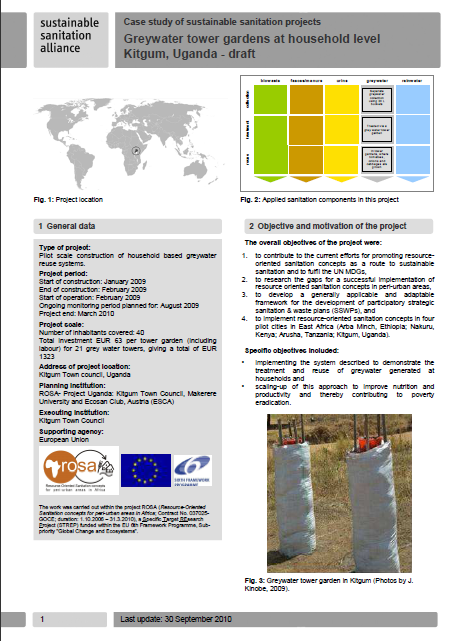Greywater tower gardens at household level Kitgum, Uganda - Case study of sustainable sanitation projects
Kinobe, J., Kulabako, R., Olweny, S. (2010)

Published in: 2010
Publisher:
Sustainable Sanitation Alliance (SuSanA)
Author:
Kinobe, J., Kulabako, R., Olweny, S.
Uploaded by:
SuSanA secretariat
Partner profile:
common upload
13538 Views
338 Downloads
Location of library entry
Content - Summary
This case study shows the use of greywater towers as a tool for household sanitation in Uganda. The project serves 40 inhabitants in Kitgum Town, Uganda. The project has been realized within the ROSA project which aims to develop adaptable, affordable and replicable sanitation solutions in Africa. The investment is EUR 63 per tower garden (including labour) for 21 greywater towers, giving a total of EUR 1323. The project was planned by the ROSA Project Uganda: Kitgum Town Council, Makerere University and Ecosan Club, Austria and executed by Kitgum Town Council with the European Union support.
Three greywater tower gardens were set up at each of the selected seven households (a total of 21 towers). The study households were trained by the research team on how to set up the tower gardens as well as on the operation and maintenance aspects for effective performance. To show the effects of this irrigation/fertilisation method, a control tower garden set up in exactly the same way as the other greywater towers and planted with the same vegetables, was irrigated with groundwater instead of greywater.
Another project component consisted of gathering information about the impact of greywater on the soil. For that, soil samples were collected from each sample household prior to greywater application and analysed for pH, organic matter, nitrogen, phosphorus and potassium content. The effect of greywater application on the soil characteristics was not significant with respect to potassium, organic matter and nitrogen content.
Tower gardens were operated in such a way that collected greywater from bathing and washing clothes was applied on a daily basis. The daily amount of greywater produced per household varied between 48 and 60 litres. Some of this greywater was used for cleaning the house as well as pit latrines, hence, not all of it was used for the tower gardens. The tower gardens are used to grow vegetables, mainly tomatoes and onions. The clear advantage of a tower garden is the reuse of greywater for vegetable growth where there is limited land and a family cannot have a big garden.
A walk through the area revealed fifteen additional households that set up greywater towers after realising the benefits associated with the study units. Through the introduction of tower gardens people got an understanding of the advantages of reusing greywater. In consequence, more households set up small vegetable gardens on their land and applied greywater directly to the plants, probably motivated by the fact that there was no extra investment required compared to that for a tower garden costing EUR 63.
Bibliographic information
Kinobe, J., Kulabako, R., Olweny, S. (2010). Greywater tower gardens at household level Kitgum, Uganda - Case study of sustainable sanitation projects. Sustainable Sanitation Alliance (SuSanA)
Filter tags
Case studies in SuSanA template Constructed wetlands English Greywater or wastewater Peri-urban Sub-Saharan Africa















